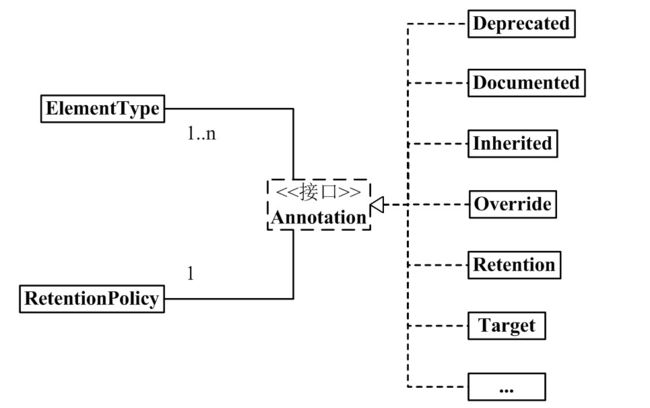什么是注解
Java Annotation是JDK5.0引入的一种注释机制,可以为程序的元素(包、类、接口、字段、方法参数、局部变量)加上更直观的说明,这些说明信息是与程序的业务逻辑无关,大多情况下供指定的工具或框架使用。
Annotation的组成
1、Annotation的架构图:
分析架构图:
1个Annotation 和 1个RetentionPolicy关联。
可以理解为:每1个Annotation对象,都会有唯一的RetentionPolicy属性。1个Annotation 和 1~n个ElementType关联。
可以理解为:对于每1个Annotation对象,可以有若干个ElementType属性。Annotation 有许多实现类,包括:Deprecated, Documented, Inherited, Override等等。
总结:Annotation 的每一个实现类,都和“1个RetentionPolicy关联”和“1~n个ElementType关联” 。
2、解析Annotation、ElementType、RetentionPolicy
- Annotation
package java.lang.annotation;
public interface Annotation {
boolean equals(Object obj);
int hashCode();
String toString();
Class annotationType();
}
- ElementType
package java.lang.annotation;
public enum ElementType {
TYPE, /* 类、接口(包括注释类型)或枚举声明 */
FIELD, /* 字段声明(包括枚举常量) */
METHOD, /* 方法声明 */
PARAMETER, /* 参数声明 */
CONSTRUCTOR, /* 构造方法声明 */
LOCAL_VARIABLE, /* 局部变量声明 */
ANNOTATION_TYPE, /* 注释类型声明 */
PACKAGE /* 包声明 */
}
- RetentionPolicy
package java.lang.annotation;
public enum RetentionPolicy {
SOURCE, /* Annotation信息仅存在于编译器处理期间,编译器处理完之后就没有该Annotation信息了 */
CLASS, /* 编译器将Annotation存储于类对应的.class文件中。默认行为 */
RUNTIME /* 编译器将Annotation存储于class文件中,并且可由JVM读入 */
}
总结三者之间的关系:
2.1 Annotation 就是个接口
每1个Annotation都与 1个RetentionPolicy关联,并且与 1~n个ElementType关联。可以通俗的理解为:每1个Annotation对象,都会有唯一的RetentionPolicy属性,至于ElementType属性,则有1~n个。
2.2 ElementType 是Enum枚举类型,它用来指定Annotation的类型,或者说使用对象的类型
每1个Annotation都与 1~n个ElementType关联。当Annotation与一个ElementType关联时,就意味着:Annotation有了一种可以应用的对象。
例如,若一个Annotation对象是METHOD类型,则该Annotation只能用来修饰方法。
2.3 RetentionPolicy 是Enum枚举类型,它用来指定Annotation的策略。通俗点说,就是不同RetentionPolicy类型的Annotation的作用域不同
每1个Annotation 都只会和 1个RetentionPolicy关联。
- 若Annotation的类型为 SOURCE,则意味着:Annotation仅存在于编译器处理期间,编译器处理完之后,该Annotation就没用了。
例如,“ @Override ”标志就是一个Annotation。当它修饰一个方法的时候,就意味着该方法覆盖父类的方法;并且在编译期间会进行语法检查!编译器处理完后,“@Override”就没有任何作用了。
若Annotation的类型为 CLASS,则意味着:编译器将Annotation存储于类对应的.class文件中,它是Annotation的默认行为。
若Annotation的类型为 RUNTIME,则意味着:编译器将Annotation存储于class文件中,并且可由JVM读入。
3、解析java定义的Annotation
理解了上面的3个类的作用之后,我们接下来可以讲解Annotation实现类的语法定义了。
@Documented
@Target(ElementType.TYPE)
@Retention(RetentionPolicy.RUNTIME)
public @interface MyAnnotation1 {
}
上面的作用是定义一个Annotation,它的名字是MyAnnotation1。定义了MyAnnotation1之后,我们可以在代码中通过“@MyAnnotation1”来使用它。其它的,@Documented, @Target, @Retention, @interface都是来修饰MyAnnotation1的。
下面分别说说它们的含义:
-
@interface
使用@interface定义注解时,意味着它实现了java.lang.annotation.Annotation接口,即该注解就是一个Annotation。“定义Annotation时,@interface是必须的。”
注意:它和我们通常的implemented实现接口的方法不同。Annotation接口的实现细节都由编译器完成。通过@interface定义注解后,该注解不能继承其他的注解或接口。
-
@Documented
类和方法的Annotation在缺省情况下是不出现在javadoc中的。如果使用@Documented修饰该Annotation,则表示它可以出现在javadoc中。定义Annotation时,@Documented可有可无;若没有定义,则Annotation不会出现在javadoc中。
-
@Target(ElementType.TYPE)
前面我们说过,ElementType 是Annotation的类型属性。而@Target的作用,就是来指定Annotation的类型属性。@Target(ElementType.TYPE) 的意思就是指定该Annotation的类型是ElementType.TYPE。这就意味着,MyAnnotation1是来修饰“类、接口(包括注释类型)或枚举声明”的注解。
定义Annotation时,@Target可有可无。若有@Target,则该Annotation只能用于它所指定的地方;若没有@Target,则该Annotation可以用于任何地方。
-
@Retention(RetentionPolicy.RUNTIME)
前面我们说过,RetentionPolicy 是Annotation的策略属性,而@Retention的作用,就是指定Annotation的策略属性。@Retention(RetentionPolicy.RUNTIME) 的意思就是指定该Annotation的策略是RetentionPolicy.RUNTIME。这就意味着,编译器会将该Annotation信息保留在.class文件中,并且能被虚拟机读取。
定义Annotation时,@Retention可有可无。若没有@Retention,则默认是RetentionPolicy.CLASS。
java 常用的Annotation:
- @Deprecated -- @Deprecated 所标注内容,不再被建议使用。
- @Override -- @Override 只能标注方法,表示该方法覆盖父类中的方法。
- @Documented -- @Documented 所标注内容,可以出现在javadoc中。
- @Inherited -- @Inherited只能被用来标注“Annotation类型”,它所标注的Annotation具有继承性。
- @Retention -- @Retention只能被用来标注“Annotation类型”,而且它被用来指定Annotation的RetentionPolicy属性。
- @Target -- @Target只能被用来标注“Annotation类型”,而且它被用来指定Annotation的ElementType属性。
- @SuppressWarnings -- @SuppressWarnings 所标注内容产生的警告,编译器会对这些警告保持静默。
由于“@Deprecated和@Override”类似,“@Documented, @Inherited, @Retention, @Target”类似;下面,我们只对@Deprecated, @Inherited, @SuppressWarnings 这3个Annotation进行说明。
3.1 @Deprecated
@Deprecated 的定义如下:
@Documented
@Retention(RetentionPolicy.RUNTIME)
public @interface Deprecated {
}
说明:
- @interface -- 它的用来修饰Deprecated,意味着Deprecated实现了java.lang.annotation.Annotation接口;即Deprecated就是一个注解。
- @Documented -- 它的作用是说明该注解能出现在javadoc中。
- @Retention(RetentionPolicy.RUNTIME) -- 它的作用是指定Deprecated的策略是RetentionPolicy.RUNTIME。这就意味着,编译器会将Deprecated的信息保留在.class文件中,并且能被虚拟机读取。
- @Deprecated 所标注内容,不再被建议使用。
注意:使用@Deprecated都会出现一横线,这一横线是编辑器对@Deprecated的处理。
3.2 @Inherited
@Inherited 的定义如下:
@Documented
@Retention(RetentionPolicy.RUNTIME)
@Target(ElementType.ANNOTATION_TYPE)
public @interface Inherited {
}
说明:
@interface -- 它的用来修饰Inherited,意味着Inherited实现了java.lang.annotation.Annotation接口;即Inherited就是一个注解。
@Documented -- 它的作用是说明该注解能出现在javadoc中。
@Retention(RetentionPolicy.RUNTIME) -- 它的作用是指定Inherited的策略是RetentionPolicy.RUNTIME。这就意味着,编译器会将Inherited的信息保留在.class文件中,并且能被虚拟机读取。
@Target(ElementType.ANNOTATION_TYPE) -- 它的作用是指定Inherited的类型是ANNOTATION_TYPE。这就意味着,@Inherited只能被用来标注“Annotation类型”。
-
@Inherited 的含义是,它所标注的Annotation将具有继承性。
假设,我们定义了某个Annotaion,它的名称是MyAnnotation,并且MyAnnotation被标注为@Inherited。现在,某个基类使用了MyAnnotation,则此类类具有了注解MyAnnotation;现在,某个子类是继承了前面的基类,由于MyAnnotation是@Inherited的(具有继承性),所以,子类也具有了注解MyAnnotation。
3.3 @SuppressWarnings
@SuppressWarnings 的定义如下:
@Target({TYPE, FIELD, METHOD, PARAMETER, CONSTRUCTOR, LOCAL_VARIABLE})
@Retention(RetentionPolicy.SOURCE)
public @interface SuppressWarnings {
String[] value();
}
说明:
@interface -- 它的用来修饰SuppressWarnings,意味着SuppressWarnings实现了java.lang.annotation.Annotation接口;即SuppressWarnings就是一个注解。
@Retention(RetentionPolicy.SOURCE) -- 它的作用是指定SuppressWarnings的策略是RetentionPolicy.SOURCE。这就意味着,SuppressWarnings信息仅存在于编译器处理期间,编译器处理完之后SuppressWarnings就没有作用了。
-
@Target({TYPE, FIELD, METHOD, PARAMETER, CONSTRUCTOR, LOCAL_VARIABLE}) -- 它的作用是指定SuppressWarnings的类型同时包括TYPE, FIELD, METHOD, PARAMETER, CONSTRUCTOR, LOCAL_VARIABLE。
TYPE意味着,它能标注“类、接口(包括注释类型)或枚举声明”。
FIELD意味着,它能标注“字段声明”。
METHOD意味着,它能标注“方法”。
PARAMETER意味着,它能标注“参数”。
CONSTRUCTOR意味着,它能标注“构造方法”。
LOCAL_VARIABLE意味着,它能标注“局部变量”。 String[] value(); 意味着,SuppressWarnings能指定参数
SuppressWarnings 的作用是,让编译器对“它所标注的内容”的某些警告保持静默。例如,"@SuppressWarnings(value={"deprecation", "unchecked"})" 表示对“它所标注的内容”中的 “SuppressWarnings不再建议使用警告”和“未检查的转换时的警告”保持沉默
补充:SuppressWarnings 常用的关键字的表格:
deprecation -- 使用了不赞成使用的类或方法时的警告
unchecked -- 执行了未检查的转换时的警告,例如当使用集合时没有用泛型 (Generics) 来指定集合保存的类型。
fallthrough -- 当 Switch 程序块直接通往下一种情况而没有 Break 时的警告。
path -- 在类路径、源文件路径等中有不存在的路径时的警告。
serial -- 当在可序列化的类上缺少 serialVersionUID 定义时的警告。
finally -- 任何 finally 子句不能正常完成时的警告。
all -- 关于以上所有情况的警告。
4、Annotation 的作用
Annotation 是一个辅助类,它在Junit、Struts、Spring等工具框架中被广泛使用,在Android平台上的工具或框架也被广泛使用,如Retrofit、ButterKnite、Arouter等等。
作用主要有以下几个方面:
- 生成文档:通过代码里标识的元数据生成 javadoc 文档
- 编译检查:通过代码里标识的元数据让编译器在编译期间进行检查验证
- 编译期动态处理:编译时通过代码里标识的元数据动态处理,例如动态生成代码
- 运行期动态处理:运行时通过代码里标识的元数据动态处理,例如使用反射注入实例
我们在编程中经常会使用到的Annotation作用有:
4.1 编译检查
Annotation具有“让编译器进行编译检查的作用”。
例如,@SuppressWarnings, @Deprecated和@Override都具有编译检查作用。
- 关于@SuppressWarnings和@Deprecated,已经在“第3部分”中详细介绍过了。这里就不再举例说明了。
- 若某个方法被 @Override的 标注,则意味着该方法会覆盖父类中的同名方法。如果有方法被@Override标示,但父类中却没有“被@Override标注”的同名方法,则编译器会报错。示例如下:
4.2 在反射中使用Annotation
在反射的Class, Method, Field等函数中,有许多于Annotation相关的接口。
这也意味着,我们可以在反射中解析并使用Annotation。
package com.skywang.annotation;
import java.lang.annotation.Annotation;
import java.lang.annotation.Target;
import java.lang.annotation.ElementType;
import java.lang.annotation.Retention;
import java.lang.annotation.RetentionPolicy;
import java.lang.annotation.Inherited;
import java.lang.reflect.Method;
/**
* Annotation在反射函数中的使用示例
*
* @author skywang
* @email [email protected]
*/
@Retention(RetentionPolicy.RUNTIME)
@interface MyAnnotation {
String[] value() default "unknown";
}
/**
* Person类。它会使用MyAnnotation注解。
*/
class Person {
/**
* empty()方法同时被 "@Deprecated" 和 “@MyAnnotation(value={"a","b"})”所标注
* (01) @Deprecated,意味着empty()方法,不再被建议使用
* (02) @MyAnnotation, 意味着empty() 方法对应的MyAnnotation的value值是默认值"unknown"
*/
@MyAnnotation
@Deprecated
public void empty(){
System.out.println("\nempty");
}
/**
* sombody() 被 @MyAnnotation(value={"girl","boy"}) 所标注,
* @MyAnnotation(value={"girl","boy"}), 意味着MyAnnotation的value值是{"girl","boy"}
*/
@MyAnnotation(value={"girl","boy"})
public void somebody(String name, int age){
System.out.println("\nsomebody: "+name+", "+age);
}
}
public class AnnotationTest {
public static void main(String[] args) throws Exception {
// 新建Person
Person person = new Person();
// 获取Person的Class实例
Class c = Person.class;
// 获取 somebody() 方法的Method实例
Method mSomebody = c.getMethod("somebody", new Class[]{String.class, int.class});
// 执行该方法
mSomebody.invoke(person, new Object[]{"lily", 18});
iteratorAnnotations(mSomebody);
// 获取 somebody() 方法的Method实例
Method mEmpty = c.getMethod("empty", new Class[]{});
// 执行该方法
mEmpty.invoke(person, new Object[]{});
iteratorAnnotations(mEmpty);
}
public static void iteratorAnnotations(Method method) {
// 判断 somebody() 方法是否包含MyAnnotation注解
if(method.isAnnotationPresent(MyAnnotation.class)){
// 获取该方法的MyAnnotation注解实例
MyAnnotation myAnnotation = method.getAnnotation(MyAnnotation.class);
// 获取 myAnnotation的值,并打印出来
String[] values = myAnnotation.value();
for (String str:values)
System.out.printf(str+", ");
System.out.println();
}
// 获取方法上的所有注解,并打印出来
Annotation[] annotations = method.getAnnotations();
for(Annotation annotation : annotations){
System.out.println(annotation);
}
}
}
4.3 根据Annotation生成帮助文档
通过给Annotation注解加上@Documented标签,能使该Annotation标签出现在javadoc中。
4.4 能够帮忙查看查看代码
通过@Override, @Deprecated等,我们能很方便的了解程序的大致结构。
另外,我们也可以通过自定义Annotation来实现一些功能。
Reference:Java Annotation认知

